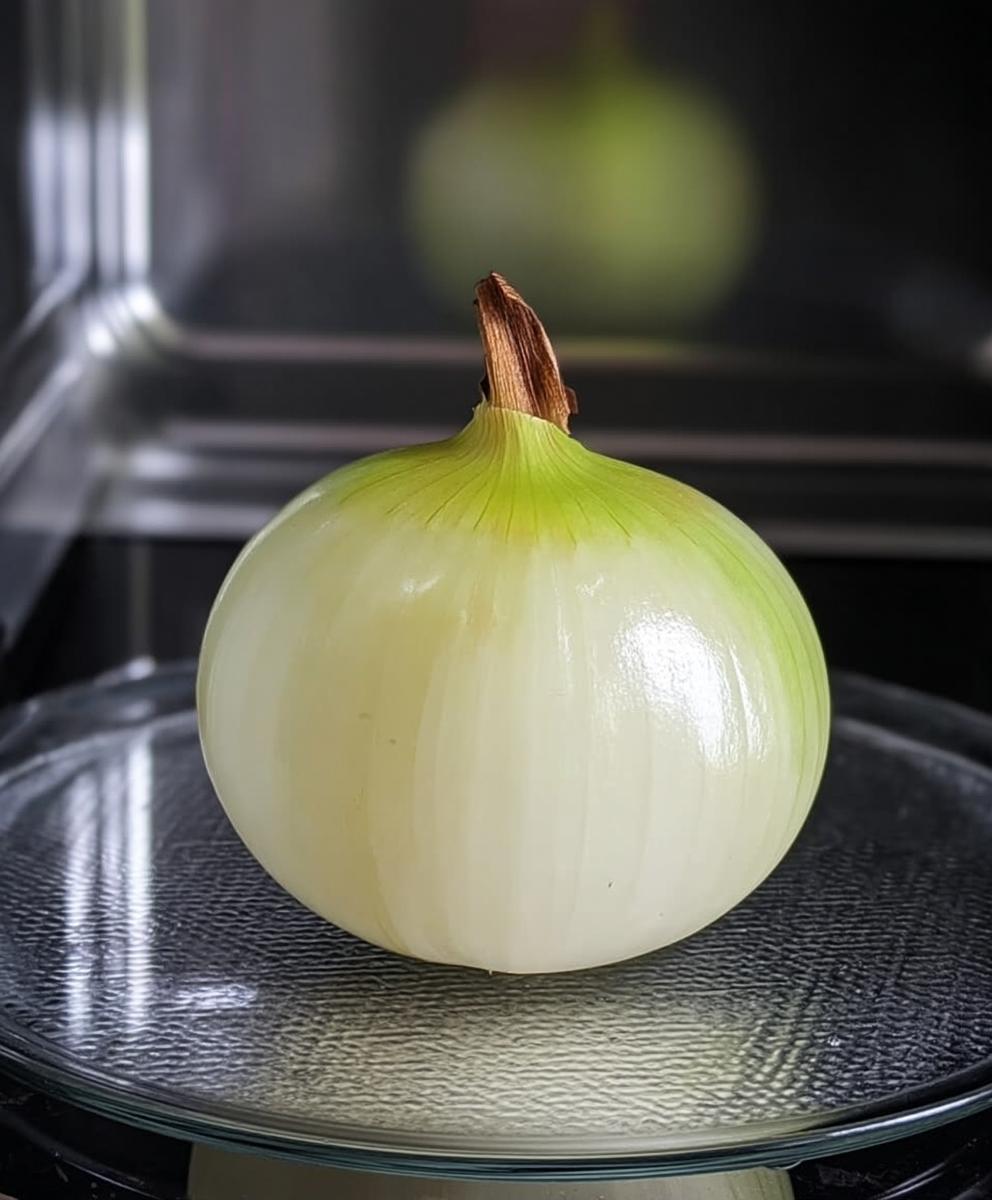Save This Recipe
Let’s start with a visual. You’re in the kitchen. Company’s coming. You’re elbow-deep in prep, and then—you remember the onions. You need something caramelized, warm, rich, comforting. You don’t have 30 minutes to stand at the stove, weeping into a skillet. What do you do?
Microwave the onion.
Sounds like a prank, right? Like some kind of grandma-invented life hack that’s more myth than meal. But here’s the thing—it works. Like, really works. And when your guests try it, they’ll think you slow-roasted those onions to perfection. Joke’s on them. You just nuked it.
Why the Microwave? Because Life’s Too Short for Tears
We’ve all had that moment. You peel an onion and suddenly it’s Niagara Falls on your face. Even if you’re not crying, prepping and sautéing onions takes time and a bit of cleanup. But the microwave shortcut? No tears. No oil splatter. No babysitting the pan. Just toss, zap, and boom—soft, savory goodness.
This isn’t some fringe TikTok trend either (though, admittedly, it would make for a great 15-second reel). It’s been floating around food blogs and whispered in home kitchens for years. It just hasn’t gone mainstream yet. Until now.
The Two-Minute Method (That’ll Change Your Onion Game)
Here’s how to do it:
-
Peel your onion. You can use yellow, white, or even red onions depending on the flavor you’re after.
-
Halve it or leave it whole. If you’re short on time, cutting it speeds things up. But whole works too!
-
Place it cut-side down (if halved) on a microwave-safe plate. Optional but smart: cover with a microwave-safe bowl or invert another plate on top. This traps steam, helps cook evenly, and keeps things from drying out.
-
Microwave on high for 2 minutes. You might need a bit longer depending on your microwave’s power, but 2 minutes is the sweet spot in most cases.
-
Let it sit. Seriously. Don’t poke it right away. It’s piping hot, and letting it rest for 30 seconds lets the flavor deepen a bit.
That’s it. You didn’t use a pan. You didn’t cry. And yet, you’ve got a tender, sweet, almost confit-like onion ready to go.
What’s the Science Behind the Sorcery?
Okay, a tiny bit of kitchen science. Onions are mostly water and sugar—like, a lot of water. When microwaved, water molecules inside vibrate like crazy, building steam that softens the onion from the inside out. This not only cooks the onion but draws out its natural sugars in a way that feels like cheating.
It’s kinda like pressure cooking, but without the pressure cooker. The result? A texture and flavor that’s ridiculously rich for the amount of effort you just put in. If you’ve ever tried to caramelize onions the traditional way, you know it takes patience and constant stirring. Here, you’ve condensed that process into two minutes flat.
Magic? Not quite. But close.
So… What Do You Even Do With It?
Honestly? Whatever you want. That’s part of the fun.
Here are some killer uses:
-
Slap it on a burger. Instant upgrade.
-
Stir it into eggs or frittatas. Adds richness without extra cooking time.
-
Mix into mashed potatoes. It adds an earthy sweetness that’s next-level.
-
Use in grilled cheese or paninis. A melty dream.
-
Top your ramen or udon. Seriously—ramen with a sweet, soft onion? Yes, please.
-
Puree with olive oil and garlic for a quick onion “jam” or sandwich spread.
-
Stuff it into tacos or wraps. Better than raw. Way better.
You could even go rogue and just eat it on its own. Add a little butter, salt, pepper… fork it up like a baked potato. It’s that good.
But Wait—Won’t It Smell?
Short answer? Yep. It’s an onion. It’s gonna do onion things.
The microwave will trap most of the scent, but once you open the door, a sweet, roasted aroma is going to waft through your kitchen. Honestly, it smells like something amazing’s happening on the stove—which works in your favor if you’re entertaining. People walk in and go, “What’s that smell?!” And you get to act mysterious.
Still, if you’re super scent-sensitive or living in a small space, crack a window or light a candle afterward. It’s not overpowering, just… aromatic.
Variations Worth Playing With
Let’s say you’ve microwaved your standard yellow onion a few times and you’re ready to spice things up. You’ve got options.
-
Red onions: A bit tangier and more colorful. Beautiful in tacos or salads.
-
Shallots: Richer, more complex flavor—perfect for sauces or dressings.
-
Sweet onions (like Vidalia): They practically caramelize themselves. Great for pizza or flatbreads.
-
Add spices post-zap: Think paprika, cumin, thyme, even a bit of curry powder.
You can also toss the microwaved onion into a hot pan after for a quick char. Gives it some of that crispy edge without the long wait.
A Tangent, But a Fun One: Lazy Onion Soup
Now, I wasn’t planning to talk about soup, but… hear me out.
You microwave a couple onions. You chop them up rough, toss into a saucepan with a splash of broth (beef or veggie), add a touch of soy sauce or Worcestershire, maybe a garlic clove. Let it simmer 10 minutes. Throw on some toasted bread and cheese if you’re feeling extra.
Boom. Lazy French onion soup. And it tastes like you made it from scratch—even though you cheated a little (okay, a lot).
Why This Hack Resonates Right Now
Let’s get real: we’re all looking for small wins in the kitchen. Something easy, fast, and satisfying that doesn’t require 30 ingredients or half your afternoon.
Microwaving an onion sounds too simple to be good—but it delivers. And in a world of 10-step recipes and endless prep lists, that’s refreshing.
Besides, there’s something deeply satisfying about tricking people into thinking you put in more effort than you actually did. It’s like the culinary version of wearing sweatpants that look like slacks.
Final Word? This Is Your New Go-To Secret Weapon
So yeah—put the onion in the microwave. Let it work its quiet little miracle. And when someone inevitably asks what you did to make it taste so good?
You just smile and say, “Oh, it’s nothing.”
(But you’ll know the truth.)

